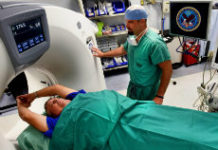Provided to more than a quarter of cancer patients, today’s targeted radiotherapy is cutting edge, cost-effective and can be curative – and has come a long way from its experimental (and Nobel prize-winning) origins
Written by Nic Fleming for Guardian Labs
 Getty Images
Getty Images
Anna Bertha Röntgen was less than impressed when, in 1895, she became the first person to see an X-ray of part of their body. “I have seen my death,” she reportedly exclaimed, on viewing the fuzzy image of the elongated, knobbly bones forming her left hand.
Her German physicist husband Wilhelm showed her the picture shortly after his discovery of a form of electromagnetic radiation, called X-rays, that allowed him to take images of body structures.
The achievement would land him the inaugural Nobel prize in physics in 1901. It also laid the groundwork for the invention of radiotherapy, which uses radiation to treat the symptoms of cancer, reduce the chances of it returning or to cure it.
 100vw, 200px”></p>
<p class=) Prof Charlotte Coles
Prof Charlotte Coles
Today, radiotherapy is provided to a quarter of patients, either on its own or alongside other forms of therapy, which equates to around 130,000 people receiving it on the NHS every year. It has won a place as a mainstay of modern cancer treatment, coming a long way since Anna Bertha’s less than enthusiastic reaction to her husband’s groundbreaking work.
Such have been the advances over the past 40 years, it is perhaps not surprising that public perception hasn’t kept up. “Radiotherapy has a bad press,” says Charlotte Coles, professor of breast cancer clinical oncology at our Cambridge Centre.
“It is often associated with words like ‘gruelling’. In reality, today’s highly targeted radiotherapy often provides the best chances of a cure with the least side effects. It’s cutting edge, cost-effective, and can be curative.”
Today’s highly targeted radiotherapy is cutting edge, cost-effective and can be curative.
Professor Charlotte Coles
 100vw, 300px”></p>
<p class=) A patient undergoing radiotherapy to the jaw in about 1929. Photograph: St Bartholomew’s Hospital
A patient undergoing radiotherapy to the jaw in about 1929. Photograph: St Bartholomew’s Hospital
Radiotherapy’s image problem is, in large part, historical. Three years after Röntgen’s breakthrough, the physicist Marie Curie discovered the chemical element radium, another source of radiation. Scientists in the US and Europe then began studying the use of radium and X-rays (here we’re talking about electromagnetic radiation, not images) to treat cancer.
It would become clear that, as ionising radiation, both could harm as well as help. Early radiologists developed leukaemia after testing their machines on their own arms, while workers painting clock and watch dials with luminescent paint containing radium ended up with radiation poisoning.
There was nonetheless growing evidence to support the use of radiation to target tumours. The British Empire Cancer Campaign (BECC), which was later renamed and then merged with another charity to form Cancer Research UK, raised significant funds to buy radium and support research into its use during the 1920s.
This support for pioneering physicists and radiologists drove advances in determining the safe doses of radiotherapy, protecting healthy tissue and improving cancer survival. In the 1930s, the BECC funded the work of the renowned English physicist Hal Gray – after whom the radiation unit of measurement the Gray is named – on how cells respond to radiation.
In the early 20th century, the X-rays used in radiotherapy were relatively low energy but in 1937 doctors and scientists at St Bartholomew’s hospital in central London, now known as Barts, began using the first system that could deliver high-energy X-rays, providing improved treatment of deep-seated tumours.
Another milestone came in 1953 with the deployment of a clinical linear particle accelerator (Linac) at Hammersmith hospital, in west London. Crucially, this demonstrated that high-energy radiotherapy beams could be delivered using affordable, reliable machines in a general hospital setting.
“Scientists in the UK have played pivotal roles throughout the development of radiotherapy technology,” says Prof David Sebag-Montefiore, clinical director of our Centre of Excellence for radiotherapy research at the University of Leeds.
What is cancer radiotherapy and how does it work?
Modern radiotherapy
For most of the history of radiotherapy, doctors were limited by the 2D images of the tumours they were targeting. Technological advances during the 1980s drove developments so that a 3D image of a tumour could be built from a series of 2D scans. The resulting image was then used to shape treatment beams that better match the tumour shape and avoid damage to healthy tissue.
Since then, advances have continued at pace.
Intensity-modulated radiation therapy (IMRT), which allows for the control of individual rays within beams of radiation, has also enabled improved targeting, especially of tumours with complex shapes.
We funded the first trial of its use in breast cancer, and then in cancers of the prostate, salivary glands, thyroid, throat and larynx, and head and neck. IMRT is now widely used to treat a range of cancers.
Image-guided radiotherapy improves precision further by allowing doctors to fine-tune treatment in response to images of tumours captured just before and during treatment. “Over the last 30 years we’ve seen dramatic changes from pretty crude tumour targeting techniques to modern Linac machines that allow us to shape radiotherapy treatment with incredible precision,” says Sebag-Montefiore.
Radiotherapy has also become less taxing for some patients thanks to changes in treatment schedules. The START trials, involving 4,450 women with early breast cancer across the UK, showed that, after surgery, lower overall doses of radiation given in fewer, larger doses were just as effective as bigger overall doses, and resulted in fewer side effects and led to improved quality of life.
As a result of the work, led by the Institute of Cancer Research, London, and part-funded by us, shorter courses of 15 treatments replaced the previous UK standard of 25 in 2008. Courses of fewer sessions are now also standard for men having radiotherapy for prostate cancer in the UK, following a 2016 report.
 100vw, 200px”></p>
<p class=) Prof David Sebag-Montefiore
Prof David Sebag-Montefiore
The researchers who led the START trials have taken this “less is more” approach even further. In 2020, they published results showing that, for women with early breast cancer, five larger daily doses is similar in both efficacy and side effects to the 15 doses. Other research has shown that treating just part of the breast with radiotherapy is as effective as treating all of it for patients at low risk of relapse.
“We can now do in a week what we had been doing over five weeks, with cancer control and side effects that are just as good, while improving the patient experience,” says Coles.
“Through other technologies such as image-guided, intensity-modulated and partial-breast radiotherapy – where radiotherapy is delivered just to the affected area rather than the whole breast – we’ve improved outcomes further. There’s no doubt the UK has led the world on this.”
This transformational investment will enable world leading research to improve the lives of future cancer patients
Professor David Sebag-Montefiore
 100vw, 300px”></p>
<p class=) Proton Beam Therapy. Photograph: The Christie NHS Foundation Trust
Proton Beam Therapy. Photograph: The Christie NHS Foundation Trust
Introducing proton beam therapy
UK scientists are also playing leading roles in research on proton beam therapy (PBT), a relatively new form of radiotherapy.
PBT uses doses of high-energy charged particles from the centre of atoms, called protons, to precisely target cancers. Its effects are highly localised. Protons are thought to cause less damage to healthy tissue and so cause fewer side effects.
In addition, since the protons are absorbed by the tumour, there is no “exit dose”, meaning that proton therapy can be used to treat tumours close to critical organs. But to understand which patients might benefit most from proton therapy, it needs to be compared against conventional treatment in clinical trials – something the NHS has included in its provision for proton therapy.
In the UK, in adults PBT is used to treat tumours which are difficult to treat by other means, and these form a national proton therapy indication list which includes cancers in the brain, base of skull and spine.
In children, teenage and young adults, it’s used to minimise the chance of them developing secondary cancers later in life. More than 630 patients have had PBT at the Christie hospital, in Manchester, since it became the first centre to offer the treatment in the UK to NHS patients in December 2018.
The Christie itself is a world recognised centre for the treatment of cancer by radiation. In the early part of the last century, its team of physicists and clinicians pioneered the use of radium, and in 1932 the hospital set the first international standards for radiation treatment.
Since then, its clinical and scientific staff have continued to play a crucial role in the advancement of cancer treatment and care, culminating in the opening of the PBT centre, the first of a national programme. A second one started treating patients in December 2021 at University College hospital in London.
Alongside treating people who have tumours on the national indication list, the two centres will also be conducting clinical trials of PBT’s wider use in breast, brain, and head and neck cancers, with other ideas for trials being developed.
The trials have been designed through collaborations across the national radiotherapy research community. “The cancer types and numbers of patients treated with proton beam therapy could increase in future, depending on the results of these trials,” says Karen Kirkby, professor of proton therapy physics at the University of Manchester and the Christie.
The radiotherapy research field received a substantial boost in 2019 when we announced RadNet, our multimillion-pound plan to establish a network of seven national centres of excellence in radiation oncology and radiobiology.
This latter field – the science of how cells and tissues respond to radiation – has huge potential to unlock future transformational advances in treatment. “This investment is truly transformational for radiotherapy research in the UK and we are really excited that this will enable world leading research to improve the lives of future cancer patients across the globe,” says Sebag-Montefiore, whose research team has received funding to investigate the use of artificial intelligence.
Among the other projects RadNet is supporting are studies to work out how to adapt radiotherapy – including PBT – based on the specific biology of a patient’s tumour, studies to find ways to sensitise patients tumours to radiation, and to find ways to target tumour cells that have evolved and become resistant to traditional radiotherapy.
Another new technique being developed is Flash radiotherapy, where the radiation dose is delivered in a fraction of a second (500-1,000 times faster than conventional radiotherapy), and appears to cause even less damage to healthy tissue while still killing tumour cells. Flash radiotherapy is very new, and can be delivered using the same machines that deliver PBT. There are a lot of questions still to be answered, but it could be used in the future to both cut treatment times and reduce side effects.
“We need to get better at telling the public about the huge strides that have been made in radiotherapy,” says Kirkby. “There’s huge potential, with researchers, clinical teams and CRUK working together to carry out more brilliant research. This will keep what the NHS is able to offer right at the cutting edge – and deliver the best possible treatment for patients.”
Professor Kirkby’s work will be showcased in ‘Revolutionising Radiotherapy’, part of Cancer Revolution: Science, innovation and hope, a new exhibition opening at the Science Museum in London May 2022. To explore some of the research featured in the exhibition visit jointhecancerrevolution.org.
This article was originally published on theguardian.com as part of the Cancer Research UK and Guardian Labs Cancer revolutionaries campaign.







